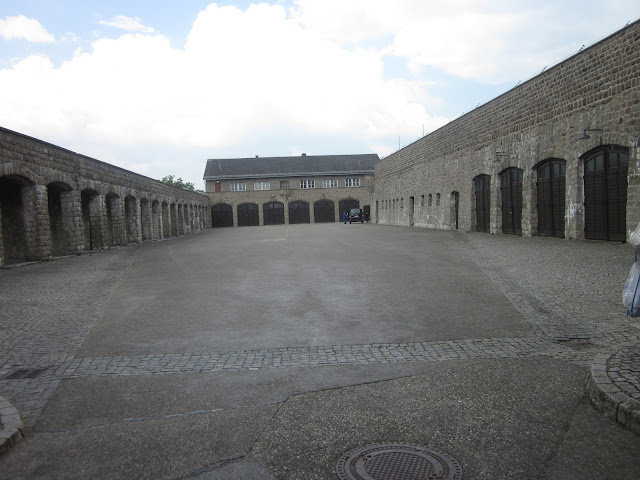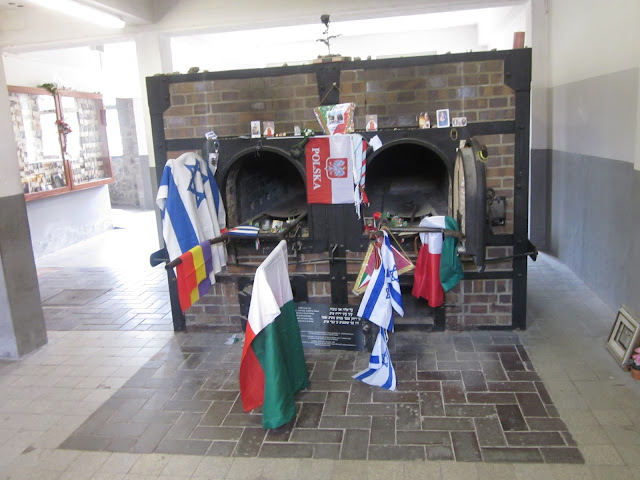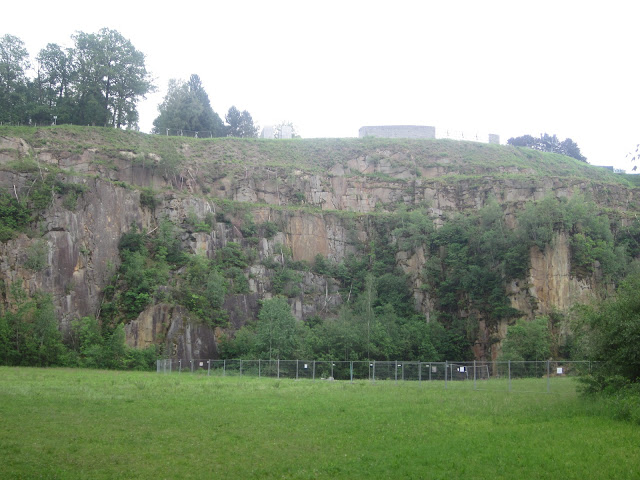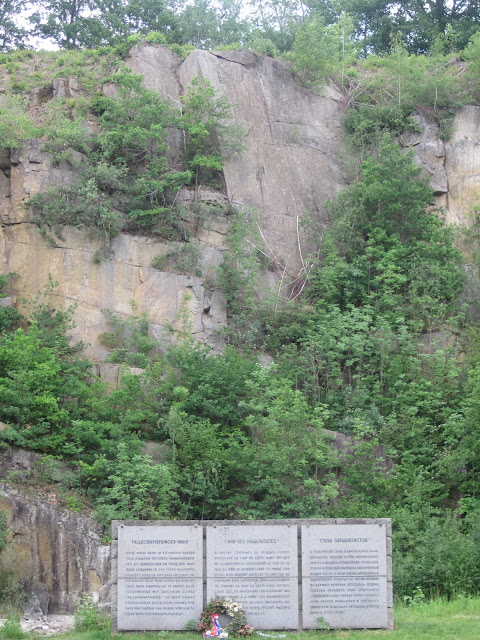On Wednesday, May 23, we rented a nice little car from Sixt and, without GPS or a decent map (another story for another day), headed out of Vienna in a generally westerly direction. We had about 160 km or 100 miles to travel, assuming we could find the place.
The Austrian countryside is beautiful, even from the window of a car speeding down the Autobahn:
I had a deja vu experience sitting in the back seat and watching the speedometer creeping ever higher. Hey siblings, do you remember Mom exceeding 100 mph on the Nevada highways?
However, the fun of driving on the Autobahn soon gave way to one of the most sobering experiences I have ever had.
On approach, Mauthausen looks like what it was: a prison. While there were Jews here, they made up less than 20% of the population. In the beginning, the inmates were primarily socialists, communists, anarchists, homosexuals, and gypsies. All of them were men. As the war wore on, however, dying prisoners were replaced with prisoners of war from conquered territories. According to Wikipedia, the largest group of prisoners was Russian, and the second largest was Polish.Towards the end of the war, overflow Jewish prisoners were sent here from Auschwitz. In September 1944, the first shipment of women arrived, and by the end of the war there were about 3,000 women. The final group of 10,000 prisoners from Auschwitz arrived in January 1945, just before Auschwitz was liberated. By the time of the liberation of Mauthausen in May of 1945, only 500 of them were still alive.
Wikipedia states, "Mauthausen was mostly used for extermination through labor of the intelligentsia, who were educated people and members of the higher social classes in countries subjugated by the Nazi regime during World War II." The labor spoken of was back-breaking work in a quarry at the base of the hill on which Mauthausen stands.
Before we went into the camp itself, we spent some time in this underground room where there are concrete carrels, each with a computer screen, where visitors can don headsets and listen to survivors' stories. English subtitles were available.
This is part of the "Mauthausen Survivors Documentation Project" carried out by Austrian scholars. Information available at the site states, "Testimonies do not just document the painful detail of suffering, terror, and struggle for survival, but also the solidarity of the inmates in one of the most horrible concentration camps of the Third Reich. . . . The interviewees do not just relate 'hard facts,' but also express their emotions . . . The interviews complement 'cold' Gestapo files, death statistics, and witnesses of stone with living recollections. They also show how the Nazi persecution is inscribed into the collective memories of different groups and nations."
The interviews provided a sobering introduction to the camp.
It was a rainy day, creating a perfect atmosphere for our visit. (Chris, where is your blue umbrella?)
What horror occurred on these beautiful cobblestone sidewalks, and what kind of men walked along these lookout walkways?
The view of the courtyard contrasted sharply with the view of the the area surrounding the camp that could be seen from the walkway:
This is one of the most lush, beautiful, peaceful scenes I have seen in all of Europe.
It made the camp that much more horrific:
Standing in the spot where not that long ago an SS officer stood:
This sculpture of a man pushing his way out of a stone slab was very fitting:
Many of the barracks were destroyed after the war, but some were preserved. During the War, there would have been much less space in between buildings. Placards near the doors gave information about what each barrack was used for. One noted that it was the former brothel. Female prisoners from Ravensbruck were brought here and forced into prostitution from mid-1942 to the spring of 1945. Male prisoners could "earn" a visit to the brothel if they met certain work production standards. Of course, prison guards also took full advantage of these women. The placard also noted that "Forced abortions and pseudo-medical experiments were conducted on women who got pregnant or were suffering from a venereal disease."
The rooms were clean and rather benign looking, not unlike the dorms at girls' camp:
Photos on the walls told another story:
This is where the quarantine barracks stood. At first, prisoners spent a few days here before being moved into the regular barracks. Later, these barracks were used for other purposes, including medical experiments:
Now the spot is a cemetery for the prisoners who died after liberation, as many of them were near starvation at that point:
The gas chamber:
. . .then the dissecting room:
. . . and finally the Krematorium, movingly decorated with the flags from the countries of executed prisoners:
The walls around the ovens were plastered with remembrances of victims:
We drove the short distance to the quarry, although it was in easy walking distance:
Work here was brutally hard, and in the winter temperatures could be as low as -22 degrees F. Inmates were malnourished and overworked, and the heavy labor took many of their lives before the gas chambers could.
This spot was known as "Parachutist's Cliff." Some accounts say guards pushed undesirables off this cliff. Other accounts say the guards forced the prisoners to push each other off. Bodies were collected at the base by fellow inmates and taken to the Krematorium.
Mauthausen was the very last concentration camp to be liberated. On May 2, 1945, the guards abandoned the camp. On May 5, 1945, the U.S. Army arrived. One of the camp's survivors was Simon Wiesenthal, a Jewish engineer who spent the rest of life working to bring Nazi criminals to justice. Because all records were destroyed, it is unknown exactly how many prisoners perished here, but it was probably around 125,000 men, women, and children.
READING
The Choice: Embrace the Impossible
 This book has three parts: the author’s childhood and time spent in Auschwitz and Mauthausen Concentration Camps, the building of her life afterwards, including marriage, family, and education, and the application of what she learned through her varied experiences to her practice as a clinical psychologist.
This book has three parts: the author’s childhood and time spent in Auschwitz and Mauthausen Concentration Camps, the building of her life afterwards, including marriage, family, and education, and the application of what she learned through her varied experiences to her practice as a clinical psychologist.
Next: The World's Response to Mauthausen
The Austrian countryside is beautiful, even from the window of a car speeding down the Autobahn:
I had a deja vu experience sitting in the back seat and watching the speedometer creeping ever higher. Hey siblings, do you remember Mom exceeding 100 mph on the Nevada highways?
 |
| That's about 83 mph--child's play for Bob |
On approach, Mauthausen looks like what it was: a prison. While there were Jews here, they made up less than 20% of the population. In the beginning, the inmates were primarily socialists, communists, anarchists, homosexuals, and gypsies. All of them were men. As the war wore on, however, dying prisoners were replaced with prisoners of war from conquered territories. According to Wikipedia, the largest group of prisoners was Russian, and the second largest was Polish.Towards the end of the war, overflow Jewish prisoners were sent here from Auschwitz. In September 1944, the first shipment of women arrived, and by the end of the war there were about 3,000 women. The final group of 10,000 prisoners from Auschwitz arrived in January 1945, just before Auschwitz was liberated. By the time of the liberation of Mauthausen in May of 1945, only 500 of them were still alive.
Wikipedia states, "Mauthausen was mostly used for extermination through labor of the intelligentsia, who were educated people and members of the higher social classes in countries subjugated by the Nazi regime during World War II." The labor spoken of was back-breaking work in a quarry at the base of the hill on which Mauthausen stands.
 |
| An interesting sculpture outside the complex, perhaps referring to the quarry work of the camp. |
This is part of the "Mauthausen Survivors Documentation Project" carried out by Austrian scholars. Information available at the site states, "Testimonies do not just document the painful detail of suffering, terror, and struggle for survival, but also the solidarity of the inmates in one of the most horrible concentration camps of the Third Reich. . . . The interviewees do not just relate 'hard facts,' but also express their emotions . . . The interviews complement 'cold' Gestapo files, death statistics, and witnesses of stone with living recollections. They also show how the Nazi persecution is inscribed into the collective memories of different groups and nations."
The interviews provided a sobering introduction to the camp.
 |
| The gate through which prisoners would have entered |
 |
| The courtyard where prisoners were gathered |
 |
| A photo of a photo taken of the "checking in" process, during which prisoners were asked to strip down for "disinfection" and then were given their prison uniforms. |
The view of the courtyard contrasted sharply with the view of the the area surrounding the camp that could be seen from the walkway:
This is one of the most lush, beautiful, peaceful scenes I have seen in all of Europe.
It made the camp that much more horrific:
Standing in the spot where not that long ago an SS officer stood:
This sculpture of a man pushing his way out of a stone slab was very fitting:
Many of the barracks were destroyed after the war, but some were preserved. During the War, there would have been much less space in between buildings. Placards near the doors gave information about what each barrack was used for. One noted that it was the former brothel. Female prisoners from Ravensbruck were brought here and forced into prostitution from mid-1942 to the spring of 1945. Male prisoners could "earn" a visit to the brothel if they met certain work production standards. Of course, prison guards also took full advantage of these women. The placard also noted that "Forced abortions and pseudo-medical experiments were conducted on women who got pregnant or were suffering from a venereal disease."
The rooms were clean and rather benign looking, not unlike the dorms at girls' camp:
Photos on the walls told another story:
 |
| Photo of camp prisoners taken by liberating forces |
Now the spot is a cemetery for the prisoners who died after liberation, as many of them were near starvation at that point:
The gas chamber:
. . .then the dissecting room:
. . . and finally the Krematorium, movingly decorated with the flags from the countries of executed prisoners:
The walls around the ovens were plastered with remembrances of victims:
We drove the short distance to the quarry, although it was in easy walking distance:
Work here was brutally hard, and in the winter temperatures could be as low as -22 degrees F. Inmates were malnourished and overworked, and the heavy labor took many of their lives before the gas chambers could.
This spot was known as "Parachutist's Cliff." Some accounts say guards pushed undesirables off this cliff. Other accounts say the guards forced the prisoners to push each other off. Bodies were collected at the base by fellow inmates and taken to the Krematorium.
A very steep stairway of 186 steps led from the base of the quarry to the top, and prisoners carried blocks of stone weighing as much as 100 pounds up these steps.
 |
| Heinrich Himmler walked up these steps on a visit to Mauthausen in 1942 |
Mauthausen was the very last concentration camp to be liberated. On May 2, 1945, the guards abandoned the camp. On May 5, 1945, the U.S. Army arrived. One of the camp's survivors was Simon Wiesenthal, a Jewish engineer who spent the rest of life working to bring Nazi criminals to justice. Because all records were destroyed, it is unknown exactly how many prisoners perished here, but it was probably around 125,000 men, women, and children.
READING
The Choice: Embrace the Impossible
by Dr. Edith Eva Eger
 This book has three parts: the author’s childhood and time spent in Auschwitz and Mauthausen Concentration Camps, the building of her life afterwards, including marriage, family, and education, and the application of what she learned through her varied experiences to her practice as a clinical psychologist.
This book has three parts: the author’s childhood and time spent in Auschwitz and Mauthausen Concentration Camps, the building of her life afterwards, including marriage, family, and education, and the application of what she learned through her varied experiences to her practice as a clinical psychologist.
Eger was a disciple of Viktor Frankl, whose story she discovered in the 1950s when a fellow student gave it to her. Her therapy is based on a version of his “choice therapy,” the idea that we cannot control what happens to us, but we can control how we respond.
I have read many books on life in concentration camps, and Dr. Eger talks about her experiences, but as a foundation for what comes later. I found the last third of her book to be the most interesting—seeing how that idea of control can actually play out in individual lives. Fascinating and thought-provoking.
Next: The World's Response to Mauthausen








































I agree, one of the most sobering experiences I've had. What a shame records were destroyed and we can only guess at the true horror of these camps.
ReplyDeleteI left my blue umbrella behind, hoping to see a pink one along the way.
Nice post. I had no real desire to go to the concentration camp, but I'm glad we did. It had a much greater impact on me than I could have imagined. I think its preservation is important and particularly given the propaganda being perpetuated that the exterminations of the Jews and others is all a myth.
ReplyDeleteGruesome, even in the midst of a beautiful countryside. A somber read about a horrific time in history.
ReplyDelete